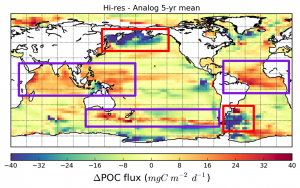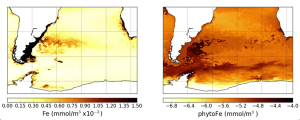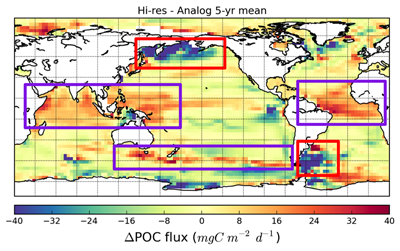
Figure 1. Difference in annual mean carbon export (ΔPOC flux) between a high resolution (0.1º, Hi-res) and standard resolution (1º, Analog) global climate model simulation using the CESM model. Highlighted regions show areas where vertical (purple boxes) and horizontal (red boxes) changes in nutrient transport drive increases or decreases in export, respectively.
Most Earth System models (ESMs) that are used to study global climate and the carbon cycle do not resolve the most energetic scales in the ocean, the mesoscale (10-100 km), encompassing eddies, coastal jets, and other dynamic features strongly affecting nutrient delivery, productivity, and carbon export. This prompts the question: What are we missing in climate models by not resolving the mesoscale?
Authors of a recent study published in Global Biogeochemical Cycles conducted a comparative analysis of the importance of mesoscale features in biological production and associated carbon export using standard resolution (1°) and mesoscale-resolving (0.1°) ESM simulations. The mesoscale-resolving ESM yielded only a ~2% reduction in globally integrated export production relative to the standard resolution ESM. However, a closer look at the local processes driving export in different basins revealed much larger, compensating differences (Fig. 1). For example, in regions where biological production is driven by natural iron fertilization from shelf sediment sources (Fig. 2), improved representation of coastal jets in the higher-resolution ESM reduces the cross-shelf iron delivery that fuels production (red boxes in Fig. 1). Resolving mesoscale turbulence further reduces the spatial extent of blooms and associated export, yielding a more patchy distribution than in the coarse resolution models. Together, these processes lead to a reduction in export in the Argentine Basin, one of the most productive regions on the planet, of locally up to 50%. In contrast, resolving the mesoscale results in enhanced export production in the Subantarctic (purple box in Fig. 1), where the mesoscale model resolves deeper, narrower mixed layer depths that support stronger nutrient entrainment, in turn enhancing local productivity and export.

Figure 2. An iron-driven plankton bloom structured by mesoscale features in the South Atlantic. Left is simulated dissolved iron (Fe), the limiting nutrient for this region, and right is iron in all phytoplankton classes, a proxy for biomass (phytoFe, shown in log10 scale), on January 11, the height of the bloom. Plankton blooms in the Subantarctic Atlantic are fueled by horizontal iron transport off coastal and island shelves and vertical injection from seamounts, whereas farther south in the Southern Ocean, winter vertical mixing is the primary driver of iron delivery. Mesoscale circulation, largely an unstructured mix of interacting jets and vortices, strongly affects the location and timing of carbon production and export. Click here for an animation.
In regions with very short productivity seasons like the North Pacific and Subantarctic, internally generated mesoscale variability (captured in the higher resolution ESM) yields significant interannual variation in local carbon export. In these regions, a few eddies, filaments or more amorphous mesoscale features can structure the entire production and export pattern for the short bloom season. These findings document the importance of resolving mesoscale features in ESMs to more accurately quantify carbon export, and the different roles mesoscale variability can play in different oceanographic settings.
Determining how to best sample these mesoscale turbulence-dominated blooms and scale up these measurements to regional and longer time means, is an outstanding joint challenge for modelers and observationalists. A key piece is obtaining the high temporal and spatial resolution data sets needed for validating modeled carbon export in bloom regions strongly impacted by mesoscale dynamics, which represent a large portion of the global carbon export.
Authors
Cheryl Harrison (NCAR, University of Colorado Boulder)
Matthew Long (NCAR)
Nicole Lovenduski (University of Colorado Boulder)
J. Keith Moore (University of California Irvine)




